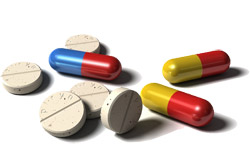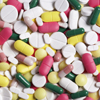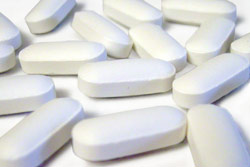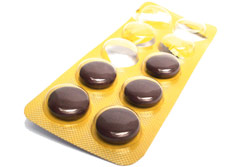- Introduction to generic and branded medicines
- What are branded medicines?
- What are generic medicines?
- Medicine labelling
- What is therapeutic bioequivalence?
- Advantages of generic medicines
- Disadvantages of generic medicines
- Why choose the branded medicine rather than the generic medicine?
- What are you paying for medication?
- Brand substitution
Introduction to generic and branded medicines

However, generic medicines are sold using a different name and may contain different inactive ingredients (ingredients that give the product its taste, shape texture, smell, et cetera, but which do not affect the body to relieve health conditions) compared with their branded counterparts. They should not be confused with counterfeit medicines, which are illegally manufactured copies that may or may not contain the same active ingredient.
The number of generic medicines being distributed in Australia is increasing. This is a move supported by the government, who have implemented a number of strategies to encourage the use of generic medicines because they are often cheaper than brand-name medicines. Use of generic medicines may also have cost benefits for the consumer and for pharmacies.
Although the use of generic medication is becoming more widely accepted by Australian doctors and consumers, many consumers in Australia (and overseas) have a mistrust of generic medicines. Furthermore, use of generic medication is still a controversial issue amongst doctors.
The generic pharmaceutical industry is growing, and these medicines are likely to become more common in Australia in the future. Increased education about generic medicines and the similarities and differences between generic and brand-name medicines is needed to allow consumers to make informed choices about which medicines they use. There is also a need for education regarding the testing that is carried out to ensure generic medicines are safe and have the same effect on the body as the brand they copy (known as therapeutic bioequivalence). Consumers also need to be aware of the risks that can be associated with switching from branded to generic medicines or vice versa.
What are branded medicines?
A branded medicine is the original product that has been developed by a pharmaceutical company. When a company develops a new medicine, their product must undergo and pass rigorous tests and evaluations to ensure that it is both effective in curing the condition it claims to treat and safe for human use. Because pharmaceutical companies invest considerable amounts of money to develop a new medicine, they are given the sole right to manufacture and distribute the medicine for a period of time.
When a pharmaceutical company is given sole rights of manufacture and distribution, the medicine is said to have a patent on it. A patent is a technical description of what the drug is and what it is used for. For a period of time after the patent is granted, no one else can produce a drug that is the same as the patented drug; the medicine belongs exclusively to the original company. For this reason, branded medicines are the most well known and most trusted type of that particular medicine.
What are generic medicines?
A generic medicine is a copy of the original branded product. Once the patent for the original product has run out, the pharmaceutical company who developed the medicine no longer has the exclusive right to produce and distribute the medicine. Other pharmaceutical companies are able to create their own version of the medicine.
The type and quantity of the active ingredient in the generic product is the same as the branded version, but the inactive ingredients are slightly different. The generic medicine is sold under a different brand name and it may look different (e.g. in colour or shape) to the original.
Pseudo-generic medicines
A pseudo-generic product is not a remake of the original; it is an exact replica of the original. It is made by the same company with exactly the same ingredients in the same way. The only difference is the name and packaging.
These medicines are usually marketed by the same manufacturer at the same price as the original. Pharmaceutical companies make pseudo-generic products to combat true generics and to discourage competitor pharmaceutical companies from entering the market for that particular medicine.
Fillers, binders and lubricants
The inactive ingredients in a medicine can include substances such as lactose, dyes and gluten. For the majority of people, making changes to these ingredients does not change the effectiveness or safety of the medicine. The differences in formulation and production will, however, change the appearance of the medicine, for example the shape, colour, taste or texture. Changing the appearance of a medicine does not change the effect it has on the body, although it may affect the ease with which a person takes the medicine (e.g. how easy it is to swallow).
Differences between generic and branded medicines are important for people who have allergies and intolerances to some of the inactive ingredients used to make the medicine. Therefore it is very important to discuss any allergies you may have with your doctor and pharmacist before you take any medication, and before you switch from using a brand-name medicine to a generic medicine or vice versa.
Medicine labelling
All prescription medication will have the brand name on the label. This is the name with the registered or copyright sign attached to it. Underneath the brand name will be the name of the active ingredient in the product. In the case of a branded and generic medicine that copies it, the label for each medicine will have a different brand name, but the same active ingredient.
What is therapeutic bioequivalence?
In order for a generic medicine to successfully enter the pharmaceutical market, it must be bioequivalent to the branded medicine. That is, the effect the generic medicine has in the body must be statistically the same as the effect the original medicine has in the body.
To determine whether two medicines are bioequivalent, a pharmaceutical company needs to scientifically show that its generic medicine has the same bioavailability as the branded medicine. That is, the medicines need to have similar absorption, distribution, metabolism and excretion.
Differences in the formulation of the generic medicine can influence these pharmacokinetic properties, and therefore can potentially affect a medicine’s safety and efficacy. For most generic medicines, the property differences from the original medicine are subtle and do not alter its overall bioavailability or its effectiveness in treating the condition it is intended for.
However, subtle changes in formulation and inactive ingredients may have significant effects in medicines with narrow therapeutic windows (the dose range in which the medicine is effective and safe). If a medicine with a small therapeutic window becomes even slightly better absorbed, a small proportion of the medicine will become more accessible in the circulation. As a result, the medicine plasma concentration (concentration of the medicine which enters the blood) could exceed the maximum therapeutic limit and potentially be unsafe.
On the other hand, if changes to the manufacturing of a medicine reduce its bioavailability, there may not be enough of the active ingredient absorbed into the body to have the desired effect. The medicine may not work as well to cure the condition it is intended for.
For these reasons, the generic medicine must undergo rigorous bioequivalence testing in order for the Therapeutic Goods Administration (TGA) to approve them for sale as generic medicines. Once a pharmaceutical company has successfully demonstrated to the TGA that the generic product is bioequivalent to the original, it can produce and market the generic. The generic medicine can also be considered for listing on the pharmaceutical benefits scheme (PBS).
Bioequivalence testing
Bioequivalence trials are not as time-consuming, costly or large-scale as clinical trials, which companies that develop new medicines must conduct to prove the safety and effectiveness of their product. However, bioequivalence trials are still considered to be rigorous evaluations of the generic medicine.
What do bioequivalence tests assess?
The aim of the trials is to compare the bioavailability of the generic medicine in question to that of the branded medicine. The bioavailabilities of the medicines are determined by:
- Peak plasma concentration: This is the maximum concentration the active ingredient reaches in the person’s blood, measured by testing a blood sample. The concentration varies based on the time since the medicine was taken. Before taking the medicine, a person will not have any active ingredient in their blood. After taking the medicine, the concentration will increase as the active ingredient is absorbed, until it reaches the peak concentration. It will then reduce until all the medicine has left the person’s bloodstream (unless more medicine is taken);
- Time taken to reach peak plasma concentration: Measured by taking a series of blood samples and recording the amount of time between the person taking the medicine and the blood sample with the peak plasma concentration being drawn.
How is bioequivalence testing conducted?
Usually, 20–40 healthy participants are used to assess the bioequivalence of two medicines. Each participant takes a dose of the branded medicine and a dose of the generic medicine, on separate occasions. It is important to leave a sufficient period of time between taking the two medicines to ensure that the first medicine has been completely eliminated from the person’s body (there is no active ingredient in their bloodstream).
The dose for both will be the same because the generic medicine must contain the same amount of active ingredient as the branded medicine. Because different bodies absorb, metabolise and eliminate medicines differently (e.g. absorption may be different in two people with different body weights), the same people take both types of medicine. Any differences between their bodies will therefore be the same for both the generic and the branded medicine tests.
What conditions must be satisfied for medicines to be considered bioequivalent?
For two medicines to be considered bioequivalent, the results of bioequivalence testing must be statistically equal in terms of peak plasma concentration and time to reach peak plasma concentration. However statistical equivalence does not mean that the two medicines are exactly the same.
Two medicines are considered bioequivalent when the values obtained from the tests are within the 80–125% range. This means that the average peak plasma concentration and time to reach peak plasma concentration for the generic medicine cannot be more than 20% below or 25% above the average values for the branded medicine.
Some doctors and scientists believe that these cut-offs are too wide. For some medicines, such as antiepileptics, this appears to be a valid concern.
 |
For more information, see Generic and Branded Antiepileptic Drugs. |
Advantages of generic drugs
The major advantage of generic medicine use is the cost benefit. Generic medicine cannot be marketed at a price higher than the branded medicine, so it is often a cheaper option, both for the consumer and the government who pays for part of the cost of the medicine under the Pharmaceutical Benefits Scheme. This may help people to take their medications as prescribed by the doctor.
More expensive medicines can sometimes affect people’s ability to strictly adhere to the dosage schedule prescribed by the doctor, especially when there are many repeats and the medicine has to be purchased on multiple occasions. In many cases, not finishing all repeats will have negative health effects: the medication will not treat the intended condition as well as it should – for example, a person’s infection may not be completely eliminated if they stop taking antibiotic medicines too early (although they will often feel fine when they stop taking the medicine). Having cheaper medication available makes it financially easier to continue with the medication for the whole duration of the prescription.
However, over two-thirds (68%) of generic medicines are the same price as the original. Despite this, research shows that over half of people (55%) don’t ask their pharmacist if the generic is any cheaper before purchasing it. If cost is the same, most Australians (62%) would prefer the original medicine their doctor prescribed over the generic their pharmacist is offering.
Disadvantages of generic medicines
Consumer confusion
Without properly understanding the similarities and differences between generic and branded medicines, it is easy to become confused and anxious about taking a new medicine. This is particularly the case when someone is used to taking a certain medicine and is introduced to a new medicine that has a different name and appearance but is ‘the same’.
There are two main points that you need to understand if you are considering the switch to generic medication:
- Even though a generic medicine may taste, look and be packaged differently, it has the same active ingredient as the branded medicine you are used to taking. Therefore, the two medicines cannot be taken together. This will lead to an overdose of that particular medicine. Always remember that one replaces or is substituted for another.
- The generic medicine has been thoroughly tested by the pharmaceutical company and the TGA. The generic medicine is interchangeable with the branded medicine. This means that it will have the same actions in the body as the original medicine. The only differences exist in the inactive ingredients, which will not have any negative effect unless you have an allergy or intolerance. However, when treating certain critical conditions such as epilepsy, the normally acceptable equivalence range is too large. In these cases, your doctor will include instructions on the prescription that substitutes should not be used and the pharmacist must not offer you a substitute.
Not understanding that the new medicine is substituting a medicine already being taken can lead to:
- Decrease in medicine adherence due to confusion and anxiety about taking the new medicine; or
- Overdose toxicity due to taking both the branded and generic forms.
If you are not comfortable with the concept of generic substitution, do not switch medicines.
How to minimise confusion
Doctors play a very important role in reducing confusion about generic medicines because their patients take advice about medicine from them and trust their doctor to prescribe effective medicines. About 50% of people involved in a study reported they would not switch to a generic medicine without first checking with their doctor. This is indeed a good precaution to take. Your doctor can assess any potential risks and help with any questions you may have about the new medication.
Make sure you have gathered all the information you need in order to understand and feel comfortable with generic medicines by following some simple guidelines:
- Education: Take the time to ask your doctor to explain the basic principles of generic medication. Ensure you understand the concept of active and inactive ingredients. Become very familiar with the active ingredient in the medication you are taking. The active ingredient is always printed on the label of every medication. By knowing what active ingredient you need to take, you will not be confused by different brand names.
- Consistency: Being consistent with your brand decision is very important. If you have switched to generic medication once, it is recommended that you continue with that brand. Multiple medicine switches will increase confusion.
- Medicine review: Make appointments to review your medications with your doctor. This will help you feel in control of the medication requirements and give you the opportunity to ask any questions you may have.
- Instructions/labels: Basic labels and instructions can be attached to medicine packaging that state clearly the dosing requirements. You can ask your pharmacist to add Label 15 to the new medication: “This medicine replaces […]. Do not use both.”
Why choose the branded medicine rather than the generic medicine?
For many people, substituting a generic copy for a brand name medicine is safe. However, you should not substitute the brand of medication you are taking if any of the following situations apply to you:
- You do not understand the change and feel anxious;
- Your doctor specifically tells you that substitution for your condition is associated with risks;
- You are allergic or intolerant to an ingredient in the substitute;
- You have dementia, a mental illness, or are taking multiple medications and are likely to get mixed up if a new medicine replaces one of them.
What are you paying for medication?
The brand premium policy/minimum pricing policy
In 1990, the PBS introduced the minimum pricing policy for pharmaceuticals. The policy states that the PBS subsidises up to the price of the cheapest version of a particular medicine. PBS subsidies make medicines cheaper for consumers because the government covers a proportion of the cost of the medicine, so that the consumer covers only a proportion of the cost, known as the consumer co-payment.
The difference in price between the cheapest generic version of a medicine and other more expensive brands (including the original) is known as the brand premium. If you choose to use the more expensive version, you pay the brand premium plus the co-payment price left after PBS subsidisation.
This can be better explained with an example:
Say Medicine X is the original branded product worth $50. Medicine Y is the generic product worth $30. The brand premium is the difference between these two prices, $20. The PBS will only subsidise up to the price of Medicine Y because it is the cheapest version.
If the PBS subsidises 50% of the cost ($30) of Medicine Y, the government pays $15 and the consumer makes a $15 co-payment. If the consumer wishes to purchase the more expensive Medicine X, the government still pays $15 and the consumer pays the co-payment price ($15) plus the brand premium price ($20), which comes to $35. Therefore Medicine Y will cost the consumer $15, and Medicine X will cost the consumer $35.
This is only an example. The price differences are not always as large between the two medicines – in fact, most brand premiums range between $1 and $4. Research shows that nearly half of Australians (44%) prefer the medicine brands that their doctor has prescribed because they trust their doctor will prescribe the correct medicine. Similarly, nearly a third (30%) have trust in the brand name and are sceptical regarding the effectiveness of generics, despite legislation requiring all generic medicines to be demonstrated equivalent prior to sale.
The brand premium policy stops any generic medicine from being marketed at a higher price than the branded medicine. Furthermore, it allows pharmaceutical companies to establish their own prices for multi-branded medicines.
The policy was put in place for a number of reasons:
- To encourage price competition between pharmaceutical companies;
- To enhance consumer and prescriber awareness of the difference in medicine costs;
- To provide consumers with the information they need to make a choice, yet not to facilitate multiple switches;
- To encourage doctors to prescribe medicines according to their active ingredients rather than their brand names;
- To encourage the generic development industry; and
- To allow companies to monitor the prices of medicines and to establish their competitor prices effectively.
Brand substitution
In 1994, a brand substitution policy was introduced to Australia. This policy states that it is possible to substitute the prescribed brand at the time of purchase, in the pharmacy. This means that when your pharmacist assesses your script, you may be asked if you would like to swap to the generic brand (as opposed to your doctor asking you at the time the prescription is given to you).
Brand substitution is accepted as long as:
- The person receiving the medicine understands and accepts the substitution;
- The doctor did not specifically state on the prescription that brand substitution was not to take place; and
- The specific substitution is permitted in the state or territory in which it was prescribed and dispensed.
For more information, please speak to your doctor.
References
- Probyn AJ. Some drugs are more similar than others: Pseudo-generics and commercial practice. Aus Health Rev. 2004;28(2):207-17. [Abstract]
- Vajda FJE. Generic substitution in epilepsy: A controversial issue. The Epilepsy Report [online]. Baulkham Hills, NSW: Epilepsy Australial; October 2006 [cited 3 April 2009]. Available from: URL link
- NPS News 55: Generic medicines: Dealing with multiple brands [online]. Strawberry Hills, NSW: National Prescribing Service; 1 December 2007 [cited 3 April 2009]. Available from: URL link
- Be medicinewise: Same medicine different brands [online]. Strawberry Hills, NSW: National Prescribing Service; 2011 [cited 11 April 2011]. Available from: URL link
- Gidal BE, Tomson Y. Debate: Substitution of generic drugs in epilepsy: Is there cause for concern? Epilepsia. 2008;49(Suppl 9):56-62. [Abstract| Full text]
- Choi L, Caffo B, Rohde C. A survey of the likelihood approach to bioequivalence trials. Stat Med. 2008;27(24):4874-94. [Abstract]
- Kesselheim AS, Misono AS, Lee JL, et al. Clinical equivalence of generic and brand-name drugs used in cardiovascular disease: A systematic review and meta-analysis. JAMA. 2008;300(21):2514-26. [Abstract | Full text]
- Heaney DC, Sander JW. Antiepileptic drugs: Generic versus branded treatments. Lancet Neurol. 2007;6(5):465-8. [Abstract]
- Substitution des médicaments antiépileptiques dans l’épilepsie [Substitution of antiepileptic drugs in epilepsy] [online]. Anatole, France: Agence française de sécurité sanitaire des produits de santé (AFSSAPS); 25 July 2008 [cited 3 April 2009]. Available from: URL link
- Kalisch LM, Roughead EE, Gilbert AL. Brand substitution or multiple switches per patient? An analysis of pharmaceutical brand substitution in Australia. Pharmacoepidemiol Drug Saf. 2008;17(6):620-5. [Abstract]
- Different brands of the same medicine (brand premiums) [online]. Tuggeranong DC, ACT: Medicare Australia: 18 January 2009 [cited 4 April 2009]. Available from: URL link
- Bulsara C, MacKenzie A, Sanfillipo F, et al. ‘Not the full Monty’: A qualitative study of seniors’ perceptions of generic medicines in Western Australia. Aust J Prim Health. 2010;16(3):240-5. [Abstract]
- Be medicinewise: Other ingredients in your medicine [online]. Strawberry Hills, NSW: National Prescribing Service; 2011 [cited 11 April 2011]. Available from: URL link
- Briggs D. Generic Medicines Study for Viva! Communications. West Chatswood, NSW: Galaxy Research; 2010.
- Australian Medicines Facts Book [online]. Deakin, ACT: Medicines Australia; 2009 [cited 11 April 2011]. Available from: URL link
- Donovan J. Is there a role for generic medicines in the pharmaceutical benefits scheme? Health Issues, 2003. [cited April 28, 2011]. Available from: [URL Link].
All content and media on the HealthEngine Blog is created and published online for informational purposes only. It is not intended to be a substitute for professional medical advice and should not be relied on as health or personal advice. Always seek the guidance of your doctor or other qualified health professional with any questions you may have regarding your health or a medical condition. Never disregard the advice of a medical professional, or delay in seeking it because of something you have read on this Website. If you think you may have a medical emergency, call your doctor, go to the nearest hospital emergency department, or call the emergency services immediately.









